Nicole M. Wolverton's Blog, page 4
November 9, 2023
Freebie to Celebrate National Scrapple Day
I get grossed out by scrapple–mostly because I’ve seen it made, and it’s not pretty. That said, who am I to poo-poo (no pun intended) National Scrapple Day? I mean, my people have farming backgrounds. My grandparents were dairy farmers… and I’ve certainly still got family who farms, from corn to pigs. So today… on this, a day to elevate scrapple… I give you a free download of “Parting Gifts,” a creative nonfiction piece of mine that was originally published in Hungry Ghost magazine back 2021. Scrapple, a family funeral… what more could you want? Head over here, click the link to get the download, and voila: some free reading for today.
November 5, 2023
The Pending Assistens
 The graveyard was awash in the sound of happy dogs. I wandered in and perched on a pine-painted bench, waiting. It wasn’t long before a man appeared, tennis ball launcher in hand, with his joyful, bounding yellow Lab. And moments later, a puppy barreled up a lane, wanting to play. The owners acknowledged each other wordlessly and went on about their business.
The graveyard was awash in the sound of happy dogs. I wandered in and perched on a pine-painted bench, waiting. It wasn’t long before a man appeared, tennis ball launcher in hand, with his joyful, bounding yellow Lab. And moments later, a puppy barreled up a lane, wanting to play. The owners acknowledged each other wordlessly and went on about their business.
Copenhagen is like that. Everyone is pleasant–yet perhaps not what you would call overtly friendly. I was speaking to a Taiwanese transplant (she’d married a Dane), and she blames it on the value placed on individual freedom. Maybe, maybe not (certainly that same value manifests differently in the U.S.), but everything about Assistens Kirkegård screams that she’s right. To start with, the graveyard is the least crowded boneyard I’ve ever seen. There are some sections where graves are lined up, one right after the other–but most of it is spread out and serene, and the whole place is very, very manicured (yet also has wildness to it). I can see why it used to be a popular place to picnic and party: in the early 1800s there was a law passed to prohibit the consumption of food or drink, the playing of music, or engaging in any other kind of “cheerful” behavior on-site. Alas, no frolicking in the place were Hans Christian Andersen and Søren Kierkegaard are buried.
Apparently the locals ignored the edict, the same as they currently do with prohibitions to biking through the graveyard. While I didn’t witness anyone partying on-grounds, I did witness dozens of people whizzing down the paths and even three people giving a guided tour by bicycle… more specifically, by giant tricycles with seating mounted to the front for full-grown adult tourists.
There is a particular feeling in Assistens, which immediately engaged my writer brain–so I do believe you’re going to see the kirkyard in an upcoming novel. Like Assistens, my kirkyard will be overrun with red squirrels. They don’t exist in the U.S., but they will in my project… but only inside the graveyard walls. I sketched out a quick plot while still in Copenhagen, and I’m excited to get started. Something to look forward to!



October 24, 2023
Monster of the Month: the Beast of Bray Road
The Beast of Bray Road has to be nearly a hundred years old—at least that’s when the rumors started. In 1936 came the report of a six or seven-foot-tall humanoid covered in black and brown fur and with a head like a wolf started circulating around Elkhorn, Wisconsin—courtesy of a night watchman at the nearby St. Coletta School for Exceptional Children. As near as I can tell, the moniker the Beast of Bray Road didn’t stick until the 1980s, though, when it was routinely sighted on the 17-mile stretch of Bray Road. The Beast of Bray Road is a lot catchier than the Beast of Elkhorn Vicinity, I guess. The point is that this wolfey-human thing has been sighted both running on four legs and walking on two, it’s enormous red or orange eyes glowing out of the dark.
It mostly seems to be a threat if you are a deer or a car trunk, though. The Beast is mostly accused of killing deer and livestock around Bray Road—or of pouncing on cars that hit it on the road, and slashing up the paint. To be fair, I’d probably scratch up someone’s paint job if they hit me with a car, too. Sightings have occurred farther afield, in Spring Prairie and Lyon. Still, no reported human deaths.

Some folks say the Beast of Bray Road is just a bear with mange or maybe a really big wolf, either of which is uncommon for the area. Others, though, theorize we’re dealing with a werewolf, though—or maybe a Bigfoot. There’s even a less popular line of thought that it’s a Native American wendingo. Whatever it really is, reports of the Beast were so frequent in the 1980s and 1990s that the Walworth County Week newspaper assigned a reporter to it. Linda Godfrey’s subsequent book, The Beast of Bray Road: Tailing Wisconsin’s Werewolf maintains that the creature could very well exist, despite the reporter finding no hard evidence for it. After all, the people who saw it know what they saw… don’t they?
Earlier this year, the Elkhorn Community Center sponsored an event to update the community on the Beast, complete with new video footage. Beware, Wisconsin, beware.
October 19, 2023
A few years ago my husband and I visited Alaska in the fa...
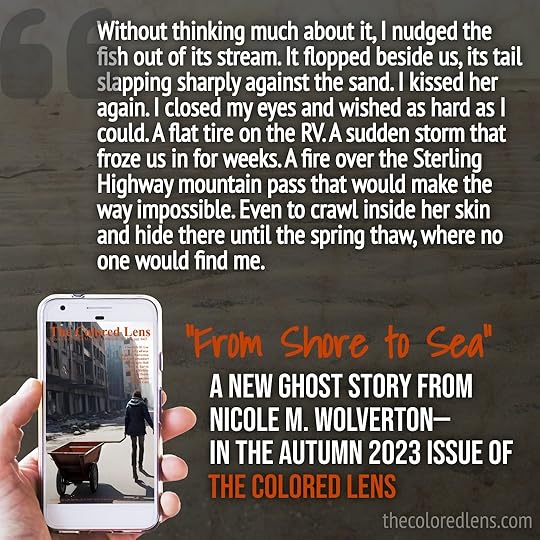 A few years ago my husband and I visited Alaska in the fall—and spent a few days in Homer. If you’re not familiar with it, it’s a small city along the southern coast, on the Kenai Peninsula. We stayed in a condo at the end of Homer Spit. All the tourist places that line the spit were closing up shop for the season, and everyone just had this strange air of longing (but also relief that the bulk of the tourists would be gone until the next summer). One day we made a pit stop at one of the beaches along the spit during bore tide and found a bunch of… well, they looked like fire rings but super fancy ones ringed in feathers, rocks, driftwood, berries, straw, etc. A short story immediately started forming in my head.
A few years ago my husband and I visited Alaska in the fall—and spent a few days in Homer. If you’re not familiar with it, it’s a small city along the southern coast, on the Kenai Peninsula. We stayed in a condo at the end of Homer Spit. All the tourist places that line the spit were closing up shop for the season, and everyone just had this strange air of longing (but also relief that the bulk of the tourists would be gone until the next summer). One day we made a pit stop at one of the beaches along the spit during bore tide and found a bunch of… well, they looked like fire rings but super fancy ones ringed in feathers, rocks, driftwood, berries, straw, etc. A short story immediately started forming in my head.
And today, that short story has been launched into the world! “Shore to Sea” is published in the Autumn 2023 issue of The Colored Lens. If I were going to pitch this story to someone, I’d tell them it’s the a ghost story and a love story—Jeannie has to leave Homer with her aunt in the morning, and it’s her last night with love-of-her-life Emma; in finding a way to make the universe keep them together forever, something goes awry.
The only thing else I can tell you about the story is that in addition to the strange rings we saw on the beach that day (and the bore tide itself), another Homer Spit sight that makes an appearance in the story is the Seafarer’s Memorial toward the end of the spit, which is in itself really creepy. There’s a life-sized bronze seafarer statue in the middle of a dimly lit memorial, so if you drive past fairly quickly it looks like a random guy standing there, staring…not to mention that there are all these plaques along the inside of the memorial that list the names of the lost, their ships, and the date on which they died—and one of the plaques has been visibly wrenched off the wall with a great deal of force. That particular thing did NOT make it into the story, but in my head it’s all related.
I do hope you’ll check out the story—if you’d like to a buy a copy of the issue, here’s the link. In the meantime, here are a few visuals to go along with our trip to Homer and what inspired “From Shore to Sea.”



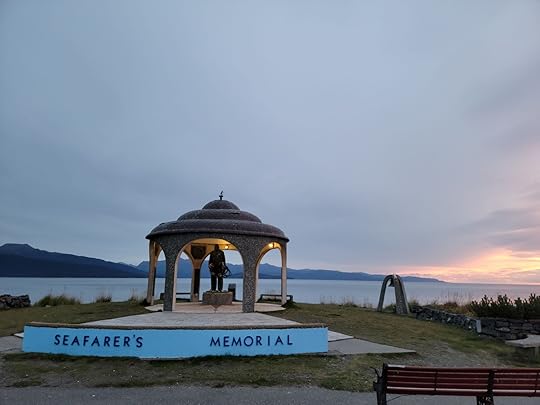
October 7, 2023
The Wordsmiths is out today!
 Months ago I saw a call for submissions as something that was being billed as a campfire anthology–but not your typical anthology of short stories. Rather, the ghost stories chosen would be part of a larger story, with characters sitting around a campfire telling the stories. I love an anthology that plays with form, and as it happened I had a ghost story that needed a home. Today that anthology is released in paperback–it’s called The Wordsmiths, and it’s put out by Hollow Oak Press. You can get a copy of your very own here.
Months ago I saw a call for submissions as something that was being billed as a campfire anthology–but not your typical anthology of short stories. Rather, the ghost stories chosen would be part of a larger story, with characters sitting around a campfire telling the stories. I love an anthology that plays with form, and as it happened I had a ghost story that needed a home. Today that anthology is released in paperback–it’s called The Wordsmiths, and it’s put out by Hollow Oak Press. You can get a copy of your very own here.
“Harvest”–my story included in The Wordsmiths–is loosely based on a story associated with my late grandparents’ farm, although my grandparents grew cows and corn, not soybeans and pumpkins like in my story. So what’s it about? It’s a very voicey story about a high school senior scoffing at an old legend about a thresher her farmer parents own that is allegedly intent on feeding blood-hungry fields. Saying much more would give some things away, but I will say that the house it’s set in is 90 percent the house my grandparents lived in when they owned the farm. The house still exists, and I often wonder if the people who now live there can still eavesdrop through the heating grates… or if any of them have heard stories about the fields, even though the house is no longer connected to a working farm.
It’s fair to say that “Harvest” is a story set in the world of Devil’s Elbow, the same world as my upcoming novel A Misfortune of Lake Monsters. That makes about five or so short stories that are set in the Devil’s Elbow world–and if you want to read four of those stories (“Harvest” isn’t included), do sign up for my monthly newsletter (the link is at the bottom of this page): newsletter subscribers get a free subscriber-only companion collection of Devil’s Elbow stories called The Devil’s Companion, Volume 1. That does imply there will be a Volume 2. Just saying…
October 6, 2023
How A Venetian Ghost Story Happened
I love the idea of situating a character with aquaphobia–the fear of water–in Venice, Italy. I visit Venice fairly regularly (since 2017, I’ve found myself in Venice four times–three times for the art biennale, and once just because), and I often wonder if anyone lives there who is afraid of water… and how they deal with it. Not only is Venice surrounded by water at every turn, the water is a regular threat to Venice’s very existence. Acqua Alta doesn’t affect all parts of Venice, but there’s also the fact that Venice is sinking at a rate of 1-2mm each year and the lagoon waters are rising. That would be terrifying for someone with a water phobia. It’s nearly impossible to get away from the sound of water, let alone the sight of it.
But that’s not how the idea for my short story “All This Water”–published in the most recent issue of Not One Of Us–was sparked. The first inkling of a story popped into my head in May 2022 when my husband and I were wandering around Cannaregio, the neighborhood in which we were staying. It’s not uncommon to see graffiti in Venice–it’s not everywhere, but it exists (there’s a book recently released, I Graffiti di Venezia, that I’m dying to lay hands on–but there’s no English translation; it’s not WHY I want to learn Italian, but yeah, I want to read this book). Near one of the bridges I ran across a stenciled word: strega. That’s the Italian word for witch. It’s also an Italian liqueur, but that’s not where my head went when I saw the word near a bridge–I was firmly thinking about witches. I saw the word several more times that day–in narrow alleyways, in the side of buildings. Of course, when I went back to grab a photo (after being obsessed all day), I couldn’t find any of them. Venice can be confusing, but that confusing?

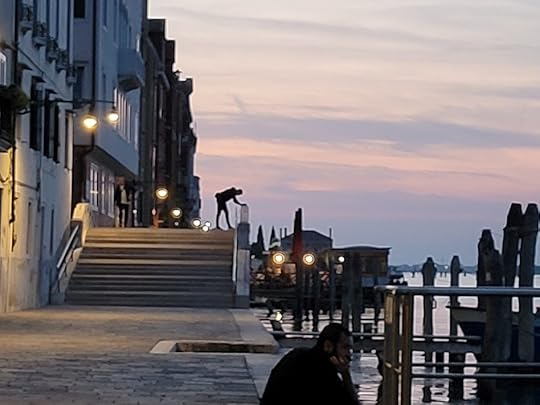
Another nugget of the story fell into place when my husband and I met up with a tour guide for a ghost walk late one night. The meeting point was the Ponte dei Mendicanti, a bridge that used to connect an ancient hospital where, once a leprosy outbreak abated in the 1600s, the poor gathered together until a hospital was built to help them. The leprosy doesn’t have anything to do with my short story–just a bit of interesting historical trivia. Anyway, the ghost walk was absolutely delightful and full of great stories, including one involving Venice’s accused witches in the 16th century. It was particularly interesting to me since I had just taken a history class about gender and the persecution of so-called witches in the U.S. and Europe the summer before.
My brain couldn’t let go of any of this–the thought of aquaphobia, the strega graffiti, the ghost walk story about accused witches, the class I’d had the summer prior–and I ended up going down a rabbit hole about the history of Venetian witchcraft, the Benandanti, Ember Days, and other random Venetian witch stories. What came out at the other end is “All This Water,” in which married couple Emily and Doyle are vacationing in Venice, despite Emily’s crippling fear of water due to several near-drowning experiences; Doyle convinces her to accompany him on a ghost walk, meeting their guide Seth at a bridge that is close to the Fondamente Nove vaporetto stop (unnamed in the story, but it’s absolutely the Ponte dei Mendicanti). The strega graffiti (slightly altered from my recollections) is involved, as is a portion of a story told on my actual tour. I won’t tell you more than that so as not to spoil the story, which I hope you decide to read (the issue of Not One Of Us is order-able here).
I’ve been thinking of “All This Water” today because I emailed our actual tour guide, who name is Alex, to send him a copy of the story. I felt compelled to note that the tour guide in our story was inspired by him, the character is not based on him. I admit that I did consider naming the tour guide Alex in tribute–but I don’t think he’d be flattered by the comparison, so I couldn’t do it. Of course, I’m also thinking of “All This Water” because I’ll be back in Venice in seven or eight months for the art biennale, and where to stay is something I was mulling over. It’s a good problem to have–as is having “All This Water” published. It really is one of my favorites.
September 20, 2023
Monster of the Month: Mongolian Death Worm
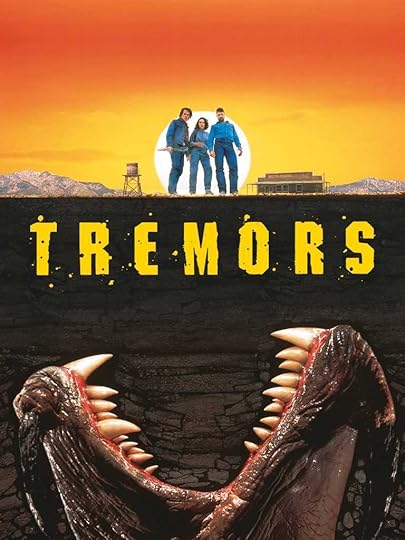 If you’ve seen the 1990 film Tremors, you have insight into this month’s feature cryptid. The Graboid, the fictional sandworm that tears everything apart in Tremors and its many sequels, is based on the infamous Mongolian Death Worm–not to be confused with Mongolian Death Worm, the metal band. Unlike the the Graboid and the Mongolian Death Worm band, though, not a single person in the world can confirm the existence of the cryptid Mongolian Death Worm. No, it is the stuff of legends.
If you’ve seen the 1990 film Tremors, you have insight into this month’s feature cryptid. The Graboid, the fictional sandworm that tears everything apart in Tremors and its many sequels, is based on the infamous Mongolian Death Worm–not to be confused with Mongolian Death Worm, the metal band. Unlike the the Graboid and the Mongolian Death Worm band, though, not a single person in the world can confirm the existence of the cryptid Mongolian Death Worm. No, it is the stuff of legends.
So, what’s a Mongolian Death Worm look like? It doesn’t sound all that terrifying, unless you find a five-foot-long, bright red sausage terrifying. That said, the venomous and corrosive saliva and the deadly electric shocks do make it feel a little less silly, as do the razor-sharp spikes that poke out of each of the sausage. It is also depicted now and then with a gaping maw filled with sharp, inward-pointing teeth. These giant crimson worms lie in wait beneath the sand, waiting for the stray camel, rodent, or human to come upon its hidey hole.
Allegedly found only in the southern Gobi Desert in Mongolia, local nomadic tribes refer to the Mongolian Death Worm as allghoi khorkhoi, which apparently means “intestine worm.” Some say the name came about because of the Mongolian Death Worm’s resemblance to cow intestines, and some say it’s because they lay their eggs in the intestines of a camel and get all bloody as a result.
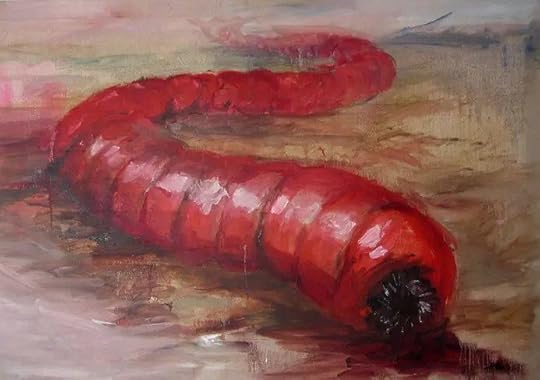
Again, there’s never been a confirmed sighting of the Mongolian Death Worm, despite a ton of expeditions and investigations. Interestingly, the same year Tremors came out, Czeck cryptozoologist Ivan Mackerle took a trip to Mongolia to seek out the worm. Apparently it didn’t go too well–Mongolians aren’t crazy about talking about it, and there was even a temporary ban on searching for the worm levied by the government. Mackerle’s book Mongolské záhady (Mongolian Mystery) declares that while he never did find it, it’s possible the Mongolian Death Worm could be real; British biologist Dr. Karl Shuker agrees, noting that it could be the carnivorous amphisbaenid, a limbless lizard that burrows in warm climates. There’s also speculation in other corners that the Mongolian Death Worm could be a death adder, a member of the cobra snake family typically found in Australia and New Guinea (they kind of look alike, and both can spit venom). Neither of those is bright red, though. Alas.
In A Misfortune of Lake Monsters, the real lake monster (as opposed to the fake lake monster, Old Lucy) gets compared to a lot of things–an alligator, an otter, and even an elephant. I’ll leave it to you to read and figure out why.
September 16, 2023
Five Books I Have Recommended A Million Times
There are books that stick with you. You read them at just the right time in your life, and they change everything. Or, at least, they make you think about things differently. These are the books I recommend to everyone–and I lend them out freely in hopes that the lendee will be rapturous after reading, ready to debate the book’s finer points and eager to discuss characters and plots. Sometimes it happens, and sometimes it doesn’t, but I never regret being that person who foists my favorites on everyone I know.
And I have–foisted them on everyone. Whether emotionally devastating, frightening, sweet, or maddening, here is a list of the five books I have recommended a million times.
 A Prayer for Owen Meany by John Irving (March 1989, William Morrow). I read Owen Meany shortly after I turned 17, and it taught me about the kind of writer I want to be, someone who can plot intricate and delicate stories, craft memorable characters, and combine genres. Most people probably consider Owen Meany literary fiction (at Amazon it’s classified as classic literary fiction and classic American fiction), but I consider it a ghost story and a story about fate. It’s also a gorgeous coming-of-age story and an anti-war story. Whenever someone asks me for a story that makes them feel something, this is the book I thrust at them.
A Prayer for Owen Meany by John Irving (March 1989, William Morrow). I read Owen Meany shortly after I turned 17, and it taught me about the kind of writer I want to be, someone who can plot intricate and delicate stories, craft memorable characters, and combine genres. Most people probably consider Owen Meany literary fiction (at Amazon it’s classified as classic literary fiction and classic American fiction), but I consider it a ghost story and a story about fate. It’s also a gorgeous coming-of-age story and an anti-war story. Whenever someone asks me for a story that makes them feel something, this is the book I thrust at them.
I’ve heard it said that one of the major themes in the book is powerlessness–and when you’re a 17-year-old girl living in a rural town, feeling like you have no agency in your life, that is something that resonates. There is also a running through-line in the novel about religious faith that charmed me. Most teens who spend time interrogating their own beliefs consider their religious beliefs, and that included me. I had already decided I was an atheist by the time I read Owen Meany, but I think of that novel every time the subject of ghosts comes up. The sheer brilliance of casting Owen as kid as the Ghost of Christmas in a play juxtaposed against against a scene in chapter 9 when John is older when he’s saved from falling down the stairs by Owen’s ghostly hand on his shoulder–“DON’T BE AFRAID. NOTHING BAD IS GOING TO HAPPEN TO YOU.” Okay, I’m shivering just thinking about it.
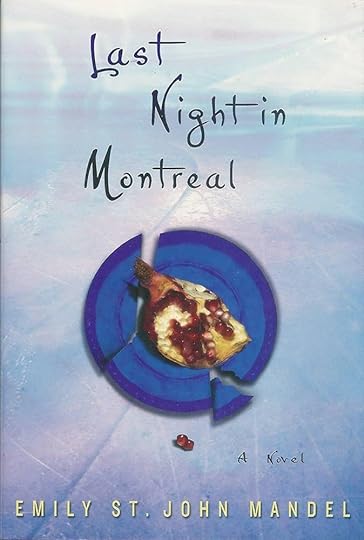 Last Night in Montreal by Emily St. John Mandel (Vintage, June 2009). When most people think about Emily St. John Mandel, they think about Station Eleven, but Last Night in Montreal was the first book I read by her–and it remains my favorite. Mandel, like Irving, is a master of weaving together multiple narratives in a very impressive way. This one is a bit of a mystery, with the reader being the one on the outside, trying to figure out Lilia Albert’s life… and why there’s a private investigator, the son of a circus lion tamer, following her.
Last Night in Montreal by Emily St. John Mandel (Vintage, June 2009). When most people think about Emily St. John Mandel, they think about Station Eleven, but Last Night in Montreal was the first book I read by her–and it remains my favorite. Mandel, like Irving, is a master of weaving together multiple narratives in a very impressive way. This one is a bit of a mystery, with the reader being the one on the outside, trying to figure out Lilia Albert’s life… and why there’s a private investigator, the son of a circus lion tamer, following her.
There’s something about the writing that has always drawn me into this book: crisp and clever:
“He told himself to stay calm, and realized in the telling that he’d been waiting for this moment. He told himself that she’d just been distracted by a bookstore. It was entirely possible. Alternatively, she liked trains: at this moment she could be halfway back from Coney Island, taking pictures of passengers, unaware of what time it was. With this in mind, he returned reluctantly to the work; a particular sentence had gotten all coiled up on him while he was trying to express something subtle and difficult, and he spent an uneasy half-hour trying to untangle the wiring and making a valiant effort not to dwell on her increasingly gaping absence, while several academic points he was trying to clarify got bored and wandered off into the middle distance. It took some time to coax them back into focus, once the sentence had been mangled beyond all recognition and the final destination of the paragraph worked out. But by the time the paragraph arrived at the station it was five o’clock, she’d left to get the paper before noon, and it no longer seemed unreasonable to think that something had gone horribly wrong.”
Who wouldn’t want to read more of that?
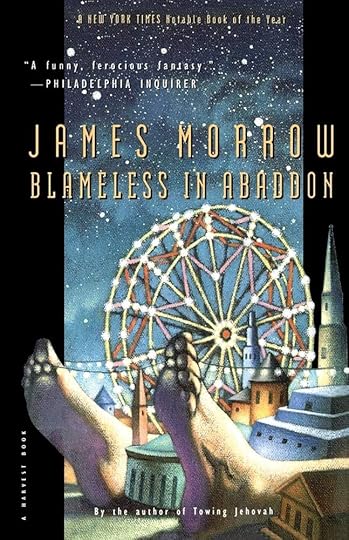 Blameless In Abaddon by James K. Morrow (Harper Voyager, September 1997). No one quite believes me when I tell them the basic plot of Blameless: The comatose, two-mile-long body of God, which had been discovered in the Arctic in the previous book in this trilogy and town to Florida, is now a tourist attraction at a religious theme park… until a very angry judge decides to put God on trial in The Hague for crimes against humanity. And it’s an absolutely hilarious, absurdist book–by a Pennsylvania writer.
Blameless In Abaddon by James K. Morrow (Harper Voyager, September 1997). No one quite believes me when I tell them the basic plot of Blameless: The comatose, two-mile-long body of God, which had been discovered in the Arctic in the previous book in this trilogy and town to Florida, is now a tourist attraction at a religious theme park… until a very angry judge decides to put God on trial in The Hague for crimes against humanity. And it’s an absolutely hilarious, absurdist book–by a Pennsylvania writer.
This book always pops into my head when bad things happen to good people since that the basic crux of the lawsuit against God, the outcome of which is–the judge hopes–to remove God from life support: a death sentence carried out on God. And, given the 1% are currently intent on destroying Democracy and the world, the following quote from Blameless feels constantly current–“Blessed are the mendacious, for they shall grown wealthy behind their wildest dreams.”
Sometimes you just need to read something that’s going to make you laugh when everything around you is falling apart… and that’s why I continue to recommend Blameless in Abaddon to everyone.
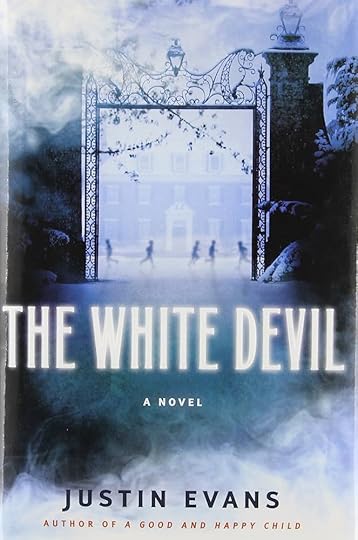 The White Devil by Justin Evans (Harper, 2011). This book is often enough a controversial pick, mostly because of how I describe it. I consider it a young adult horror novel, even though it was marketed (and continues to be marketed) as and adult literary ghost story. People can be weirdly loyal to how things are pitched to them. Whatever the case, the reason I keep giving this book to people is that it’s an excellent story about being haunted.
The White Devil by Justin Evans (Harper, 2011). This book is often enough a controversial pick, mostly because of how I describe it. I consider it a young adult horror novel, even though it was marketed (and continues to be marketed) as and adult literary ghost story. People can be weirdly loyal to how things are pitched to them. Whatever the case, the reason I keep giving this book to people is that it’s an excellent story about being haunted.
It features an American teen who’s gotten himself into a bit of trouble, exiled to the Harrow School in England to finish out his education–and fielding visits from a strange, pale boy who may or may not be a ghost. And then there’s the American teen’s striking resemblance to the poet Lord Byron, who just happens to be a graduate of Harrow School. Part murder mystery, part gay love story, part Gothic ghost story, The White Devil always gives the chills, and sometimes that’s exactly what you need.
 Monstrilio by Gerardo Sámano Córdova (Zando, March 2023). Monstrilio is a recent addition to the list, and people in my life are absolutely sick to death of hearing me talk about it. This, like Blameless in Abaddon, is a book where no one quite believes me once I’ve finished describing it. A grieving mother cuts out a piece of lung from her very recently dead kid, and–based entirely on hope and an old folktale–she feeds the lung piece until it gains sentience and grows into a carnivorous humanoid that takes her son’s place.
Monstrilio by Gerardo Sámano Córdova (Zando, March 2023). Monstrilio is a recent addition to the list, and people in my life are absolutely sick to death of hearing me talk about it. This, like Blameless in Abaddon, is a book where no one quite believes me once I’ve finished describing it. A grieving mother cuts out a piece of lung from her very recently dead kid, and–based entirely on hope and an old folktale–she feeds the lung piece until it gains sentience and grows into a carnivorous humanoid that takes her son’s place.
The book is described as literary horror–and yes, the writing is beautifully simple:
“I wanted him to snap, to finally and absolutely lose it. To break. He was withering. To wither is not the same as to break; to break is to have pieces to put back together, and to wither is to dry up, to wilt, to lose bone, to die, and death is the most boring.”
The writing is not why I keep recommending this book, though–it’s far more than that. While this is absolutely a horror novel, it’s also a book about grieving/mourning–done in a way that I’ve never quite seen before. And Monstrilio himself, well, you’re meant to find him grotesque while at the same time you fall deeply in love with him for his innocence. The dichotomy is strange and lovely.
So there you go, my five books. If you’re ever at my house, you can always count on me having a spare copy to hand out–but be prepared later on to sit down over a cup of tea to talk about plot and character!
August 22, 2023
Monster of the Month: Snallygaster
It’s the early 1900s, and you’re traveling across Frederick County, Maryland. A huge shadow passes over you and your horse, and maybe you don’t think anything of it—that is, until a huge creature with a massive wingspan and a long, pointed beak dive-bombs you from above, screeching like a train whistle and tracking you with the single eye perched in the middle of its forehead. You urge your horse faster, but that thing swoops again, faster, and this time its steel-hook claws digs into your shirt. It snatches you off your horse, sinks its teeth into your neck, and drains you of blood before releasing your body to splat all over the road and your very terrified horse.
You’ve been a victim of the Snallygaster.
To be fair, the legend of the Snallygaster existed long before the early 20th century—it originated in the 1730s as a half-bird, half-demon when German immigrants settled in the Frederick County area. At that point, it was called the Schnellegeister, or “quick spirit” in German or Pennsylvania Dutch, depending on who you ask. It stole chickens and rabbits, small goats and lambs, maybe a child or two, and farmers might paint hex signs on their barns to ward it off. Eventually Schnellegeister morphed into Snallygaster—and with that bastardization of the word, moonshiners co-opted it as a way to keep nosy people away from stills during Prohibition in the U.S. And it also somehow came to be known as having… tentacles protruding from its beak.
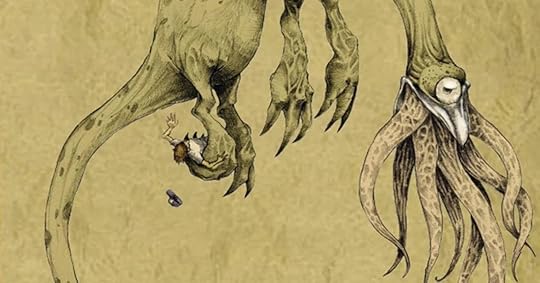
It was only then that people started to pay closer attention. Local newspapers ran articles. Then came articles from Baltimore Sun and the Washington Post. Folks started to visit to see if they could find the Snallygaster or get a photo. People in other states started reporting sightings. The National Geographic was just about to mount an expedition to get it on film when the Baltimore Sun reported the Snallygaster’s death in November 1932, allegedly to avoid a panic, but it seemed to coincide with feds blowing up the very booze still the Snallygaster had drowned in. Prohibition ended, and so did Snallygaster fever.
To this day, there has never been another sighting of the Snallygaster. But there is a Snallygaster Museum that should be open in Frederick, Maryland in a few months, so you can always stop by and sort of having your very own sighting.
Don’t think I’m not tempted to fit the Snallygaster into a novel down the road… but for now I’m excited about introducing you to Old Lucy in next year’s A Misfortune of Lake Monsters.
August 17, 2023
Farewell, heaving bosoms
There’s been discussion on Bluesky lately about how publishing is moving away the traditional hunky shirtless stud-heaving bosom woman romance cover aesthetic—potentially because it is popular among self-published work, and traditional publishing wishes to differentiate itself further. Now, I’m generally not the target audience for romance novel covers, but it did get me thinking about what I value in book covers.
I am very much a Judge A Book By Its Cover kind of person. If I know about a book, and I want to read it, the book cover matters very little to me. However, if I’m set loose in a bookstore with nothing particular in mind, I purchase entirely based on cover. My typical genres are YA and horror/speculative/supernatural (often combined), but I also read literary as well. The library in my home office (two six-shelf bookcases, as opposed to my much larger six six-shelf library downstairs) is primarily devoted to YA and YA horror. I randomly picked five books from my collection with book covers I love:

Most of these are a little older, owing to the fact that most of my reading is done on a Kindle these days—but I’d be willing to bet most of my favorite digital books there have this look, too. There are definitely some commonalities among those covers I picked. It’s a fair bet to say my aesthetic is exceedingly simple, spare, and bold—single image concepts, for the most part. Under normal circumstances I’d say that I am not overly fond of serif fonts, but the majority of these are—so maybe the real answer here is that I generally like very readable, bold fonts.
There’s a trend right now in YA books toward illustration, usually an illustration of the main character(s). I’m not super fond of that. To me it feels a little too cartoon-like… a little young. If we’re looking at who the audiences are for YA, yes, obviously we’re looking at teens—I’m sure some marketing team, after scads of marketing research, landed on illustrated characters as what really sells a book to the average sixteen-year-old. The first two books above could be illustrations, but they’re more photo-realistic looking than others I’ve seen recently. Harper’s summer 2023 YA book covers, for instance, have that characteristic in most of their fiction titles. It took me a minute to realize this, but they have an appearance I’ve come to associate with chick lit (a term I hate).
I suppose that makes sense in a weird way—an awful lot of YA is bought and read by adult women. This might be another way to lean away from self-publishers, too—original illustrated covers aren’t cheap, and many self-publishing writers don’t have the budget for it. My immediate reaction to cartoony, illustrated covers, though, is that they infantilize both groups of buyers (gee, infantilizing women and teens? Who would have heard of such a crazy thing? /s). It’s not like a lot of these illustrated covers aren’t pretty. They are. Some of them are gorgeous. Still, it might be time to buck the trend. Beyond my own personal opinions, the market is oversaturated with this look.
Interestingly (at least to me), YA horror does buck that aesthetic trend more often–with perhaps half of the titles I’m seeing recently being more in my aesthetic.

I haven’t read any of these, although all of them are on my TBR pile. And if I were wandering in a bookstore, they’re absolutely what I would pick up based on cover alone. Nothing too busy or messy, good readable fonts—confident and bold covers that have a point of view. That’s the joy of a great book cover design that appeals to you personally.



